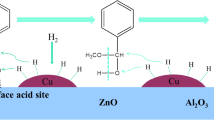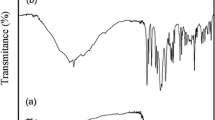Abstract
The potential of cucurbit[5]uril to be used as inverse phase transfer catalyst in electrocatalytic hydrogenation of α,β-unsaturated ketones is illustrated. The interaction behavior among isophorone and cucurbit[5]uril was also investigated using cyclic voltammetry and UV/vis absorption spectroscopy. The results concerning to both techniques revealed an enhancement in the intensity of the absorption peak and also in the current cathodic peak of isophorone in presence of cucurbit[5]uril. This achievement is related to the increase of the isophorone solubility in the medium being an indicative of a host-guest complex formation. The electrochemical hydrogenation of isophorone using cucurbit[5]uril was more efficient than others well-stablish methodologies. Regarding to (R)-(+)-pulegone and (S)-(+)-carvone, the use of cucurbit[5]uril leads to an increase of 17% and 9%, on average, respectively, in the yields when compared to the control reaction. The efficiency of selective C=O bond hydrogenation of 1-acetyl-1-cyclohexene was evaluated. The presence of cucurbit[5]uril increased by 12% the hydrogenations yields of 1-acetyl-1-cyclohexene when compared to the control reaction. In this sense, these results open up an opportunity to carry out electrocatalytic reactions within the cucurbit[5]uril environment.




Similar content being viewed by others
References
Hazra, S., Hossain, M., Kumar, G.S.: Studies on α-, β-, and γ-cyclodextrin inclusion complexes of isoquinoline alkaloids berberine, palmatine and coralyne. J. Incl. Phenom. Macrocycl. Chem. 78, 311–323 (2014). https://doi.org/10.1007/s10847-013-0301-6
Vilar, M., Navarro, M.: β-Cyclodextrin as inverse phase transfer catalyst on the electrocatalytic hydrogenation of organic compounds in water. Electrochim. Acta (2012). https://doi.org/10.1016/j.electacta.2011.10.094
Vilar, M., Navarro, M.: Determination of cyclodextrin inclusion constant for aromatic carbonyl compounds through spectrophotometric and electrochemical methods. Electrochim. Acta (2010). https://doi.org/10.1016/j.electacta.20.10.08.079
Koner, A.L., Nau, W.M.: Cucurbituril encapsulation of fluorescent dyes. Supramol. Chem. 19, 55–66 (2007). https://doi.org/10.1080/10610270600910749
Pandey, S., Soni, V.K., Choudhary, G., Sharma, P.R., Sharma, R.K.: Understanding behaviour of vitamin-C guest binding with the cucurbit[6]uril host. Supramol. Chem. 29, 387–394 (2017). https://doi.org/10.1080/10610278.2016.1243791
Chapin, J.C., Kvasnica, M., Purse, B.W.: Molecular encapsulation in pyrogallolarene hexamers under nonequilibrium conditions. J. Am. Chem. Soc. 134, 15000–15009 (2012). https://doi.org/10.1021/ja305252t
Bagatin, I.A., Cruz, A.T., Toma, H.E., Politi, M.J., Demets, G.J.F.: Synthesis of a naphthalimide functionalized calix[4]arene; a host type fluorophore for inclusion compounds in organic medium. J. Incl. Phenom. 52, 189–193 (2005). https://doi.org/10.1007/s10847-004-6385-2
Takacs, Z., Brotin, T., Dutasta, J.P., Lang, J., Todde, G., Kowalewski, J.: Inclusion of chloromethane guests affects conformation and internal dynamics of cryptophane-D host. J. Phys. Chem. B. 116, 7898–7913 (2012). https://doi.org/10.1021/jp303469x
Zhang, C., Shen, W., Fan, R., Zhang, G., Shuang, S., Dong, C., Choi, M.M.F.: Spectral study on the inclusion complex of cryptophane-E and CHCl3. Spectrochim. Acta 75, 157–161 (2010). https://doi.org/10.1016/j.saa.2009.10.004
Connors, K.A.: The stability of cyclodextrin complexes in solution. Chem. Rev. 97, 1325–1358 (1997). https://doi.org/10.1021/cr960371r
Uekama, K., Hirayama, F., Irie, T.: Cyclodextrin drug carrier systems. Chem. Rev. 98, 2045–2076 (1998). https://doi.org/10.1021/cr970025p
Lawtrakul, L., Viernstein, H., Wolschann, P.: Molecular dynamics simulations of β-cyclodextrin in aqueous solution. Int. J. Pharm. 256, 33–41 (2003). https://doi.org/10.1016/S0378-5173(03)00060-7
Liu, L., Guo, Q.X.: The driving forces in the inclusion complexation of cyclodextrins. J. Incl. Phenom. 42, 1–14 (2002). https://doi.org/10.1023/A:1014520830813
Li, S., Purdy, W.C.: Cyclodextrins and their applications in analytical chemistry. Chem. Rev. 92, 1457–1470 (1992). https://doi.org/10.1021/cr00014a009
de Medeiros, A.O., da Paz, J.A., Sales, A., Navarro, M., de Menezes, F.D., Vilar, M.: Statistical design analysis of isophorone electrocatalytic hydrogenation: the use of cyclodextrins as inverse phase transfer catalysts. J. Incl. Phenom. Macrocycl. Chem. 87, 13–20 (2017). https://doi.org/10.1007/s10847-016-0672-6
Saenger, W., Jacob, J., Gessler, K., Steiner, T., Hoffmann, D., Sanbe, H., Koizumi, K., Smith, S.M., Takaha, T.: Structures of the common cyclodextrins and their larger analogues beyond the doughnut. Chem. Rev. 98, 1787–1802 (1998). https://doi.org/10.1021/cr9700181
Szejtli, J.: Utilization of cyclodextrins in industrial products and processes. J. Mater. Chem. 7, 575–587 (1997). https://doi.org/10.1039/a605235e
Assaf, K.I., Nau, W.M.: Cucurbiturils: from synthesis to high-affinity binding and catalysis. Chem. Soc. Rev. 44, 394–418 (2015). https://doi.org/10.1039/C4CS00273C
Masson, E., Ling, X., Joseph, R., Kyeremeh-Mensah, L., Lu, X.: Cucurbituril chemistry: a tale of supramolecular success. RSC Adv. 2, 1213–1247 (2012)
Monflier, E., Tilloy, S., Fremy, G., Castanet, Y., Mortreux, A.: A further breakthrough in biphasic, rhodium-catalyzed hydroformylation: the use of Per(2,6-di-O-methyl)-β-cyclodextrin as inverse phase transfer catalyst. Tetrahedron Lett. 36, 9481–9484 (1995). https://doi.org/10.1016/0040-4039(95)02073-X
Tilloy, S., Bricout, H., Monflier, E.: Cyclodextrins as inverse phase transfer catalysts for the biphasic catalytic hydrogenation of aldehydes: a green and easy alternative to conventional mass transfer promoters. Green Chem. 4, 188–193 (2002). https://doi.org/10.1039/b108405b
Strimbu, L., Liu, J., Kaifer, A.E.: Cyelodextrin-capped palladium nanoparticles as catalysts for the Suzuki reaction. Langmuir 19, 483–485 (2003). https://doi.org/10.1021/la026550n
Freeman, W.A., Mock, W.L., Shih, N.Y.: Cucurbituril. J. Am. Chem. Soc. 103, 7367–7368 (1981). https://doi.org/10.1021/ja00414a070
Behrend, R., Meyer, E., Rusche, F.: Ueber Condensationsproducte aus Glycoluril und Formaldehyd. Justus Liebigs Ann. Chem. 339, 1–37 (1905). https://doi.org/10.1002/jlac.19053390102
Kim, J., Jung, I.-S., Kim, S.-Y., Lee, E., Kang, J.-K., Sakamoto, S., Yamaguchi, K., Kim, K.: New cucurbituril homologues: syntheses, isolation, characterization, and X-ray crystal structures of cucurbit[n]uril (n = 5, 7, and 8). J. Am. Chem. Soc. 122, 540–541 (2000). https://doi.org/10.1021/JA993376P
Mock, W.L., Irra, T.A., Wepsiec, J.P., Adhya, M.: Catalysis by cucurbituril. The significance of bound-substrate destabilization for induced triazole formation. J. Org. Chem. 54, 5302–5308 (1989). https://doi.org/10.1021/jo00283a024
Koner, A.L., Márquez, C., Dickman, M.H., Nau, W.M.: Transition-metal-promoted chemoselective photoreactions at the cucurbituril rim. Angew. Chem. Int. Ed. 50, 545–548 (2011). https://doi.org/10.1002/anie.201005317
Barooah, N., Pemberton, B.C., Sivaguru, J.: Manipulating photochemical reactivity of coumarins within cucurbituril nanocavities. Org. Lett. 10, 3339–3342 (2008). https://doi.org/10.1021/ol801256r
Anastas, P., Eghbali, N.: Green chemistry: principles and practice. Chem. Soc. Rev. 39, 301–312 (2010). https://doi.org/10.1039/b918763b
Jicsinszky, L.: Catalytic transfer hydrogenation of cyclodextrin azides and benzylated glucose derivatives. J. Incl. Phenom. Mol. Recognit. Chem. 18, 247–254 (1994). https://doi.org/10.1007/BF00708731
Zahalka, H.A., Januszkiewicz, K., Alper, H.: Olefin oxidation catalyzed by palladium chloride using cyclodextrins as phase transfer agents. J. Mol. Catal. 35, 249–253 (1986). https://doi.org/10.1016/0304-5102(86)87030-4
Harada, A., Hu, Y., Takahashi, S.: Cyclodextrin-palladium chloride. New catalytic system for selective oxidation of olefins to ketones. Chem. Lett. 12, 2083–2084 (1986). https://doi.org/10.1246/cl.1986.2083
Baur, M., Frank, M., Schatz, J., Schildbach, F.: Water-soluble calix[n]arenes as receptor molecules for non-polar substrates and inverse phase transfer catalysts. Tetrahedron 57, 6985–6991 (2001). https://doi.org/10.1016/S0040-4020(01)00653-6
Maiorova, N.A., Stepanov, A.A., Grachev, M.K., Kurochkina, G.I., Grinberg, V.A.: Electrochemical hydrogenation of acetophenone and methyl-4-isobutylacetophenone in a two-phase water organic system containing beta-cyclodextrin. Russ. J. Electrochem. 40, 1074–1078 (2004)
Farnia, G., Sandonà, G., Fornasier, R., Marcuzzi, F.: Electrochemical reduction of carbonyl compounds in aqueous media in the presence of β-cyclodextrin. Reduction of acetophenone and p-methoxyacetophenone in alkaline solution. Electrochim. Acta 35, 1149–1155 (1990). https://doi.org/10.1016/0013-4686(90)80031-I
Amatore, C., Buriez, O., Labbé, E., Verpeaux, J.N.: Supramolecular effects of cyclodextrins on the electrochemical reduction and reactivity of aromatic carbonyl compounds. J. Electroanal. Chem. 621, 134–145 (2008). https://doi.org/10.1016/j.jelechem.2007.07.029
Pedrotti, J.J., Angnes, L., Gutz, I.G.R.: Miniaturized reference electrodes with microporous polymer junctions. Electroanalysis 8, 673–675 (1996). https://doi.org/10.1002/elan.1140080713
McIntosh, A.I., Watson, D.J., Burton, J.W., Lambert, R.M.: Heterogeneously catalyzed asymmetric C=C hydrogenation: origin of enantioselectivity in the proline-directed Pd/isophorone system. J. Am. Chem. Soc. 128, 7329–7334 (2006). https://doi.org/10.1021/ja061104y
Flego, C., Perego, C.: Acetone condensation as a model reaction for the catalytic behavior of acidic molecular sieves: a UV–Vis study. Appl. Catal. A 192, 317–329 (2000). https://doi.org/10.1016/S0926-860X(99)00410-X
Zuman, P., Spritzer, L.: Differences in products of electroreduction of some unsaturates aldehydes and ketones. J. Electroanal. Chem. Interfacial Electrochem. 69, 433–434 (1976). https://doi.org/10.1016/S0022-0728(76)80146-5
Ryvolová-KejharováP, A.: Zuman: polarographic reduction of aldehydes and ketones: VIII. Polarographic behaviour of chalcone and dihydrochalcone. J. Electroanal. Chem. Interfacial Electrochem. 21, 197–219 (1969). https://doi.org/10.1016/S0022-0728(69)80039-2
Zuman, P.: Aspects of electrochemical behavior of aldehydes and ketones in protic media. Electroanalysis 18, 131–140 (2006). https://doi.org/10.1002/elan.200503367
Pemberton, B.C., Raghunathan, R., Volla, S., Sivaguru, J.: From containers to catalysts: supramolecular catalysis within cucurbiturils. Chemistry 18, 12178–12190 (2012). https://doi.org/10.1002/chem.201202083
Lessard, J.: Electrocatalytic hydrogenation. In: Kreysa, G., Ota, K., Savinell, R.F. (eds.) Encyclopedia of Applied Electrochemistry. Springer, New York (2014)
Nagaonkar, U.C., Bhagwat, S.S.: Selective reduction of isophorone in micellar media. Ind. Eng. Chem. Res. 46, 1923–1927 (2007). https://doi.org/10.1021/ie0603870
Hou, Y., Ren, S., Niu, M., Wu, W.: Improvement of the selectivity of isophorone hydrogenation by Lewis acids. R. Soc. Open Sci. (2018). https://doi.org/10.1098/rsos.171523
Pisarek, M., Łukaszewski, M., Winiarek, P., Kedzierzawski, P., Janik-Czachor, M.: Selective catalytic hydrogenation of isophorone on Ni–Al alloy modified with Cr. Mater. Chem. Phys. 114, 774–779 (2009). https://doi.org/10.1016/j.matchemphys.2008.10.027
Zouaoui, A., Stéphan, O., Ourari, A., Moutet, J.C.: Electrocatalytic hydrogenation of ketones and enones at nickel microparticles dispersed into poly(pyrrole-alkylammonium) films. Electrochim. Acta 46, 49–58 (2000). https://doi.org/10.1016/S0013-4686(00)00533-8
Coche, L., Ehui, B., Limosin, D., Moutet, J.C.: Electrocatalytic hydrogenation using precious metal microparticles in redox-active polymer films. J. Org. Chem. 55, 5905–5910 (1990). https://doi.org/10.1021/jo00310a025
Chambrion, P., Roger, L., Lessard, J., Béraud, V., Mailhot, J., Thomalla, M.: The influence of surfactants on the electrocatalytic hydrogenation of organic compounds in micellar, emulsified, and hydroorganic solutions at Raney nickel electrodes. Can. J. Chem. 73, 804–815 (1995). https://doi.org/10.1139/v95-101
Vannice, M.A., Sen, B.: Metal-support effects on the intramolecular selectivity of crotonaldehyde hydrogenation over platinum. J. Catal. 115, 65–78 (1989). https://doi.org/10.1016/0021-9517(89)90007-9
Ponec, V.: On the role of promoters in hydrogenations on metals; α, β-unsaturated aldehydes and ketones. Appl. Catal. A 149, 27–48 (1997). https://doi.org/10.1016/S0926-860X(96)00250-5
Mahdavi, B., Chambrion, P., Binette, J., Martel, E., Lessard, J.: Electrocatalytic hydrogenation of conjugated enones on nickel boride, nickel, and Raney nickel electrodes. Can. J. Chem. 73, 846–852 (1995). https://doi.org/10.1139/v95-105
Vilar, M., Oliveira, J.L., Navarro, M.: Investigation of the hydrogenation reactivity of some organic substrates using an electrocatalytic method. Appl. Catal. A (2010). https://doi.org/10.1016/j.apcata.2009.09.041
Acknowledgements
The authors would like to acknowledge IFPE and CNPq (456523/2014-6) granting for financial support.
Author information
Authors and Affiliations
Corresponding author
Ethics declarations
Conflict of interest
The authors declare no conflict of interest.
Additional information
Publisher's Note
Springer Nature remains neutral with regard to jurisdictional claims in published maps and institutional affiliations.
Electronic supplementary material
Below is the link to the electronic supplementary material.
Rights and permissions
About this article
Cite this article
Sales, A., de Oliveira e Castro, I.A., de Menezes, F.D. et al. Cucurbit[5]uril-mediated electrochemical hydrogenation of α,β-unsaturated ketones. J Incl Phenom Macrocycl Chem 95, 295–305 (2019). https://doi.org/10.1007/s10847-019-00944-4
Received:
Accepted:
Published:
Issue Date:
DOI: https://doi.org/10.1007/s10847-019-00944-4




